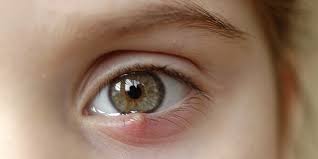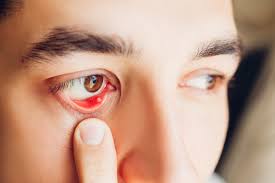If you’ve ever had a stye, you know how annoying they can be. However, did you realize that they; can a stye cause a headache? We’ll discuss the connection between styes and headaches in this blog article, along with some pain relief options.
What is a Stye or Hordeolum?
A stye, sometimes called a “hordeolum” A stye is a painful, red lump on the eyelid that develops from an acute infection or inflammation of the glands that secrete oil from the eyelid. In the event that the gland is obstructed, the oil it produces will get clogged and push through the gland wall, creating a lump. Tenderness and burning may result from a stye that develops on the lower or upper eyelid.
4 Causes of stye in the Eye
The major causes of stye in the eye are as follow.
1. Bacterial Infection
Staphylococcus aureus is the primary cause of stye and is often present on the skin. The infection of the sebaceous gland, commonly referred to as the oil gland, or the hair follicles in the eyelids may be the reason.
2. Poor Hygiene
The main factor causing eye infections is our personal hygiene practices. It may occur if we use a contaminated makeup applicator or touch and massage our eyes without cleaning our hands. These methods can potentially infect and spread microorganisms to the ocular region.
3. Blockage of Oil Glands
We have minuscule meibomian glands at the base of our lashes that secrete oil. When they become clogged, it can cause an infection, inflammatory eyes, or oil buildup, resulting in a stye.
4. Eyelash Infection
Many environmental causes and poor hygiene practices can cause an infection near the base of the lash, resulting in a stye.
Types of Styes
Bacterial infections are the primary cause of styes, and they can affect the roots of lashes or the little oil gland located at the rear of the eyelid. The bacteria that cause this illness coexist and usually do not pose a threat to humans. However, they can cause the development of a small, painful lump known as a stye if they become lodged in oil glands or the base of an eyelash. According to their categorisation, there are two kinds of stye.
1. External Stye
This is the most common kind of stye. Usually, it’s visible on the outside of the eyelids close to the corners. a stinging, red lump on the skin that might seem like a pimple or boil. When the staphylococcus aureus bacteria infect the oil gland or the hair follicle at the base of the eyelashes, an external stye occurs.This illness causes a sore, uncomfortable enlarged corner of the eyelid as a side effect.
2. Internal Stye
In comparison to its external equivalents, it is quite uncommon. It is more complex since it appears inside the eyelid. The primary cause of an internal stye is an infection of the meibomian gland, or oil gland, which is a component of the eyelid. The internal stye, in contrast to the external stye, is not apparent but can cause swelling, discomfort, and the formation of a lump inside the eyelid.
Can a Stye Cause a Headache?
When attempting to connect your suffering to an underlying illness, you may find that the formation of an external or internal stye is uncomfortable. Sometimes, you can get enthralled and attempt to locate a connection or answer the question, “Can a Stye Cause a Headache?” It is a painful red lump that is less likely to create a headache and is apparent in cases of external stye. A headache may be a “referred pain” as it causes us to feel uncomfortable. Since both are close together, certain irritated nerves may cause a headache. There may be further explanations.
1. Eye Strain
Tension and headaches can result from strained eyesight, a common source of eye pain and discomfort. Squinting or changing your normal eyesight due to a stye can be uncomfortable since it can generate stress and exacerbate an already existing headache.
2. Discomfort and Pain
A stye can produce localised pain, swelling, and redness in the eyelid, which can be quite uncomfortable. Tense and uncomfortable eyelids can aggravate pre-existing headaches by causing stress and strain.
3. Lack of Sleep
The body’s innate propensity is to become restless anytime it experiences discomfort. Our bodies can produce specific chemical formations that lead to worry and stress, which causes restlessness. Headaches are inevitable when we are sleep-deprived.

5 Treatment Options for Styes
Following are the top remedies for Styes.
Warm Compresses
Without any medical intervention, most sties resolve independently in a few days to a week. Make sure the hot water used to prepare the warm compress doesn’t burn or hurt the sensitive skin around your eyes.
Although popping or bursting a stye might harm the structure of your eyelid and encourage the bacterial infection to spread, you can alternatively try softly massaging your eyelid.
Keep the eye area clean
You may accomplish this by using a face cloth or clean cotton ball soaked in warm water to wipe away any discharge from your eyes, but always remember to wash your hands before handling your eyes.
When healing from a stye, keep your hands clean, avoid using contact lenses, and avoid applying makeup around your eyes since these things might irritate the glands in your eyes more.
Further Management
While the majority of stitches will heal on their own, some will require medical attention from a doctor. While styes are often simple to identify, they can occasionally be confused with other eyelid lesions. See your eye care provider immediately if you encounter any symptoms, such as ulceration or flaking skin surrounding the lump, or if the lashes fall out in that area.
Antibiotics to Treat a Stye
The first line of therapy for a stye is usually warm compresses; antibiotics might be contentious. Even though there is little evidence to support the use of antibiotics as a treatment for styes, some doctors continue to recommend oral antibiotics for styes that are internal or at risk of spreading to other parts of the body (a medical emergency) or antibiotic ointment to be applied to the outer edge of your eyelid where the stye is located.
Surgery for a Stye
Your eye doctor can advise surgical removal if your internal stye is not improving quickly. This entails squeezing the stye’s contents out through a tiny incision.
How to Prevent Styes?
A stye is more likely to occur in certain persons than in others. While heeding these recommendations can lower your chance of getting a stye, complete prevention of styes is not certain. Maintaining proper contact lens care; throwing off eye makeup every three months; and washing your hands before touching your eyes
Conclusion
This blog has attempted to investigate the potential causes of headaches and styes. While stye is not directly linked to headaches, it can cause a great deal of discomfort when it is present. Upon discovering the possible link between stye and headaches, we can state that localized discomfort, swelling, redness, and many other symptoms of this kind can cause anxiety, insomnia, and stress in a person.
These are more than sufficient to give someone a headache. However, if you get recurrent headaches and a stye, we advise speaking with a healthcare professional. They will examine you in great detail and provide consoling suggestions.
Also Read : Do Blind People Cry? Lets Explore Everything about Blindness in Detail



